Effective Business Communication for Australian Workplace: Essay
VerifiedAdded on 2022/12/28
|8
|2516
|33
Essay
AI Summary
This essay examines effective business communication within the context of an international agricultural products supplier based in Australia, which has recently onboarded new staff from overseas. It provides a detailed overview of Australian business communication practices, including verbal and nonverbal communication styles, cultural nuances, and the importance of directness and humor. The essay identifies competent and incompetent communication characteristics, offering recommendations for the new employees to ensure they can communicate effectively in the Australian workplace. It explores key aspects such as self-awareness, adaptability, and empathy, while also addressing the pitfalls of incompetent communication, such as poor listening skills and language barriers. Ultimately, the essay aims to equip the new employees with the knowledge and skills necessary to navigate the Australian business environment successfully.
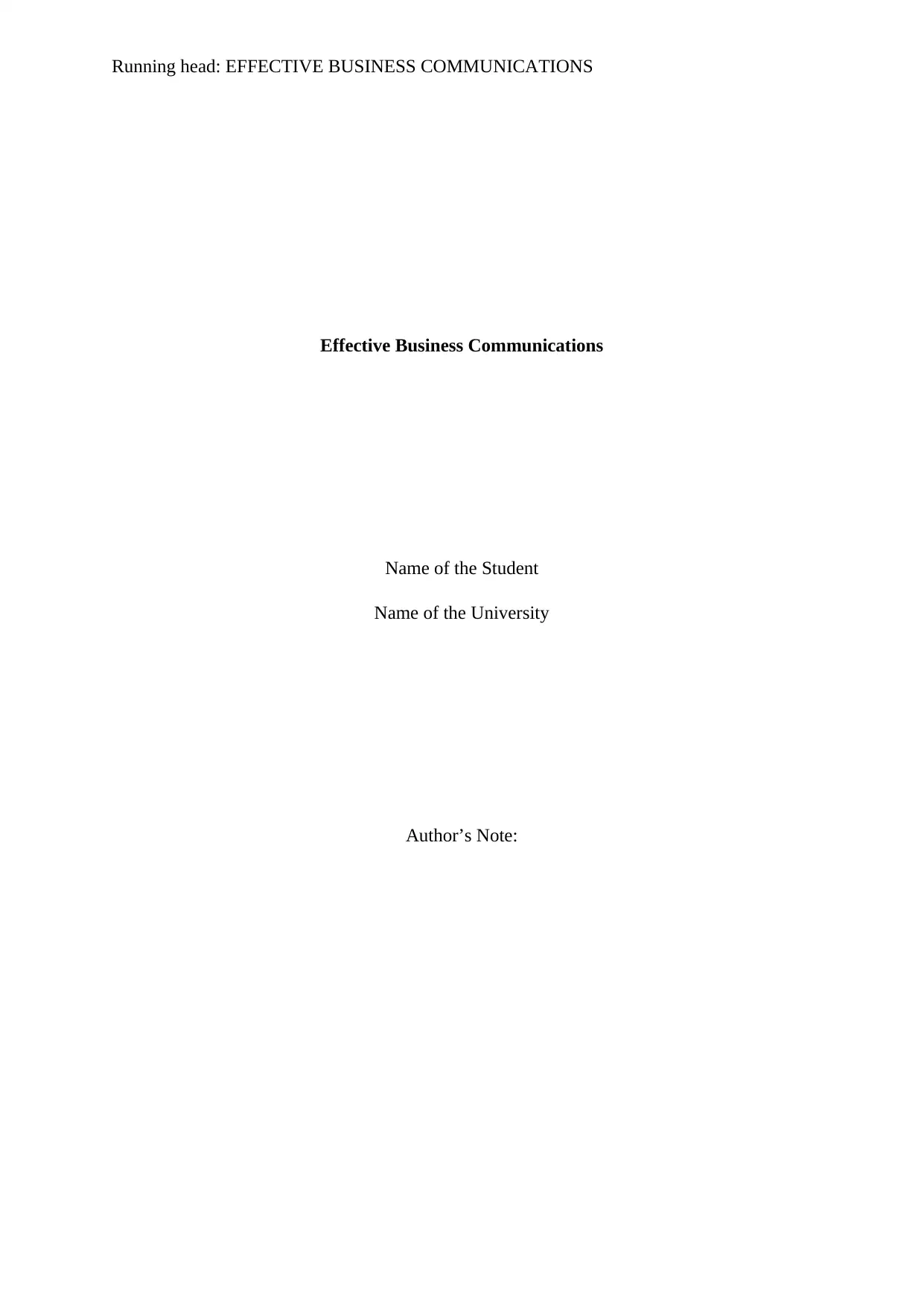
Running head: EFFECTIVE BUSINESS COMMUNICATIONS
Effective Business Communications
Name of the Student
Name of the University
Author’s Note:
Effective Business Communications
Name of the Student
Name of the University
Author’s Note:
Paraphrase This Document
Need a fresh take? Get an instant paraphrase of this document with our AI Paraphraser
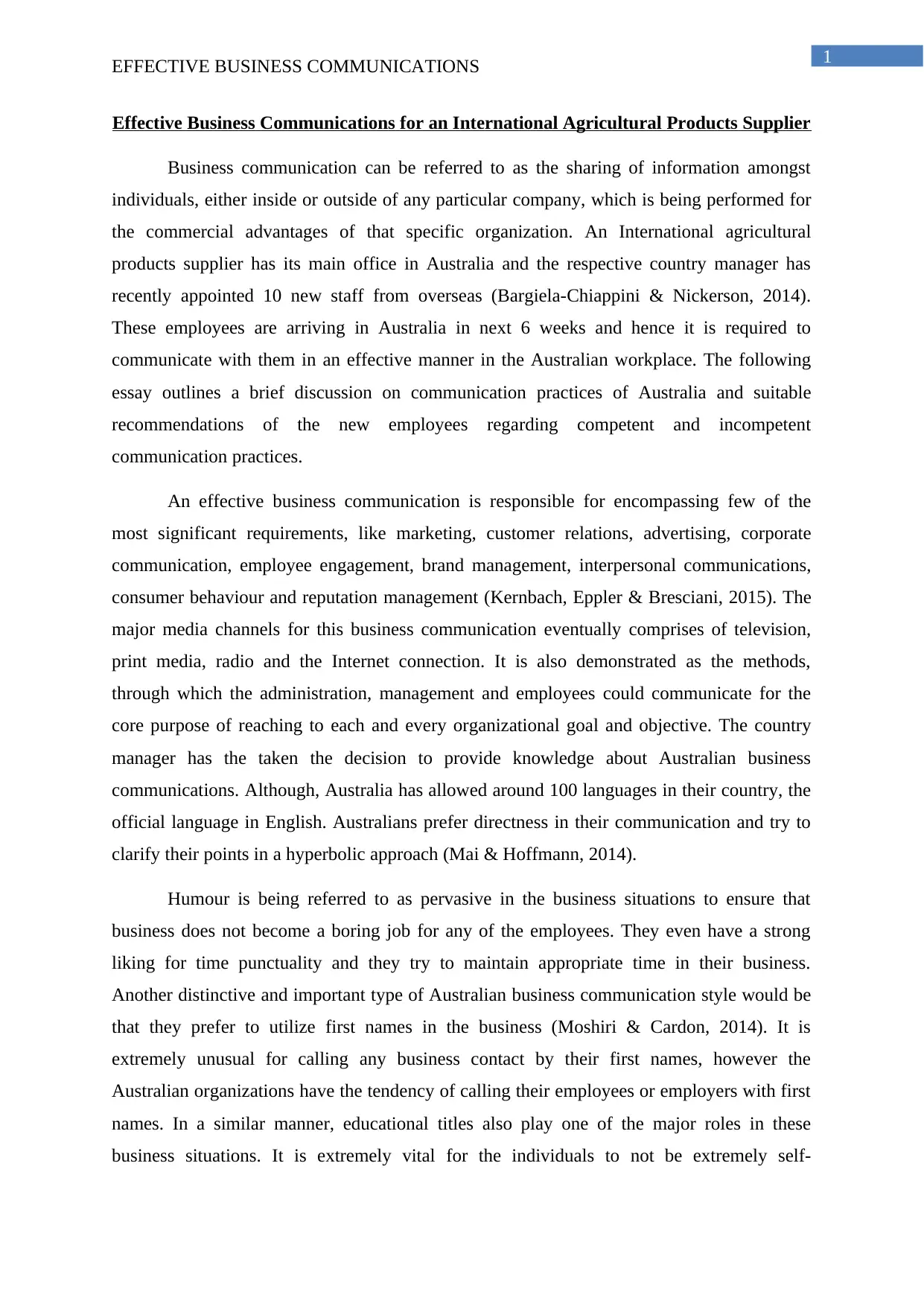
1
EFFECTIVE BUSINESS COMMUNICATIONS
Effective Business Communications for an International Agricultural Products Supplier
Business communication can be referred to as the sharing of information amongst
individuals, either inside or outside of any particular company, which is being performed for
the commercial advantages of that specific organization. An International agricultural
products supplier has its main office in Australia and the respective country manager has
recently appointed 10 new staff from overseas (Bargiela-Chiappini & Nickerson, 2014).
These employees are arriving in Australia in next 6 weeks and hence it is required to
communicate with them in an effective manner in the Australian workplace. The following
essay outlines a brief discussion on communication practices of Australia and suitable
recommendations of the new employees regarding competent and incompetent
communication practices.
An effective business communication is responsible for encompassing few of the
most significant requirements, like marketing, customer relations, advertising, corporate
communication, employee engagement, brand management, interpersonal communications,
consumer behaviour and reputation management (Kernbach, Eppler & Bresciani, 2015). The
major media channels for this business communication eventually comprises of television,
print media, radio and the Internet connection. It is also demonstrated as the methods,
through which the administration, management and employees could communicate for the
core purpose of reaching to each and every organizational goal and objective. The country
manager has the taken the decision to provide knowledge about Australian business
communications. Although, Australia has allowed around 100 languages in their country, the
official language in English. Australians prefer directness in their communication and try to
clarify their points in a hyperbolic approach (Mai & Hoffmann, 2014).
Humour is being referred to as pervasive in the business situations to ensure that
business does not become a boring job for any of the employees. They even have a strong
liking for time punctuality and they try to maintain appropriate time in their business.
Another distinctive and important type of Australian business communication style would be
that they prefer to utilize first names in the business (Moshiri & Cardon, 2014). It is
extremely unusual for calling any business contact by their first names, however the
Australian organizations have the tendency of calling their employees or employers with first
names. In a similar manner, educational titles also play one of the major roles in these
business situations. It is extremely vital for the individuals to not be extremely self-
EFFECTIVE BUSINESS COMMUNICATIONS
Effective Business Communications for an International Agricultural Products Supplier
Business communication can be referred to as the sharing of information amongst
individuals, either inside or outside of any particular company, which is being performed for
the commercial advantages of that specific organization. An International agricultural
products supplier has its main office in Australia and the respective country manager has
recently appointed 10 new staff from overseas (Bargiela-Chiappini & Nickerson, 2014).
These employees are arriving in Australia in next 6 weeks and hence it is required to
communicate with them in an effective manner in the Australian workplace. The following
essay outlines a brief discussion on communication practices of Australia and suitable
recommendations of the new employees regarding competent and incompetent
communication practices.
An effective business communication is responsible for encompassing few of the
most significant requirements, like marketing, customer relations, advertising, corporate
communication, employee engagement, brand management, interpersonal communications,
consumer behaviour and reputation management (Kernbach, Eppler & Bresciani, 2015). The
major media channels for this business communication eventually comprises of television,
print media, radio and the Internet connection. It is also demonstrated as the methods,
through which the administration, management and employees could communicate for the
core purpose of reaching to each and every organizational goal and objective. The country
manager has the taken the decision to provide knowledge about Australian business
communications. Although, Australia has allowed around 100 languages in their country, the
official language in English. Australians prefer directness in their communication and try to
clarify their points in a hyperbolic approach (Mai & Hoffmann, 2014).
Humour is being referred to as pervasive in the business situations to ensure that
business does not become a boring job for any of the employees. They even have a strong
liking for time punctuality and they try to maintain appropriate time in their business.
Another distinctive and important type of Australian business communication style would be
that they prefer to utilize first names in the business (Moshiri & Cardon, 2014). It is
extremely unusual for calling any business contact by their first names, however the
Australian organizations have the tendency of calling their employees or employers with first
names. In a similar manner, educational titles also play one of the major roles in these
business situations. It is extremely vital for the individuals to not be extremely self-
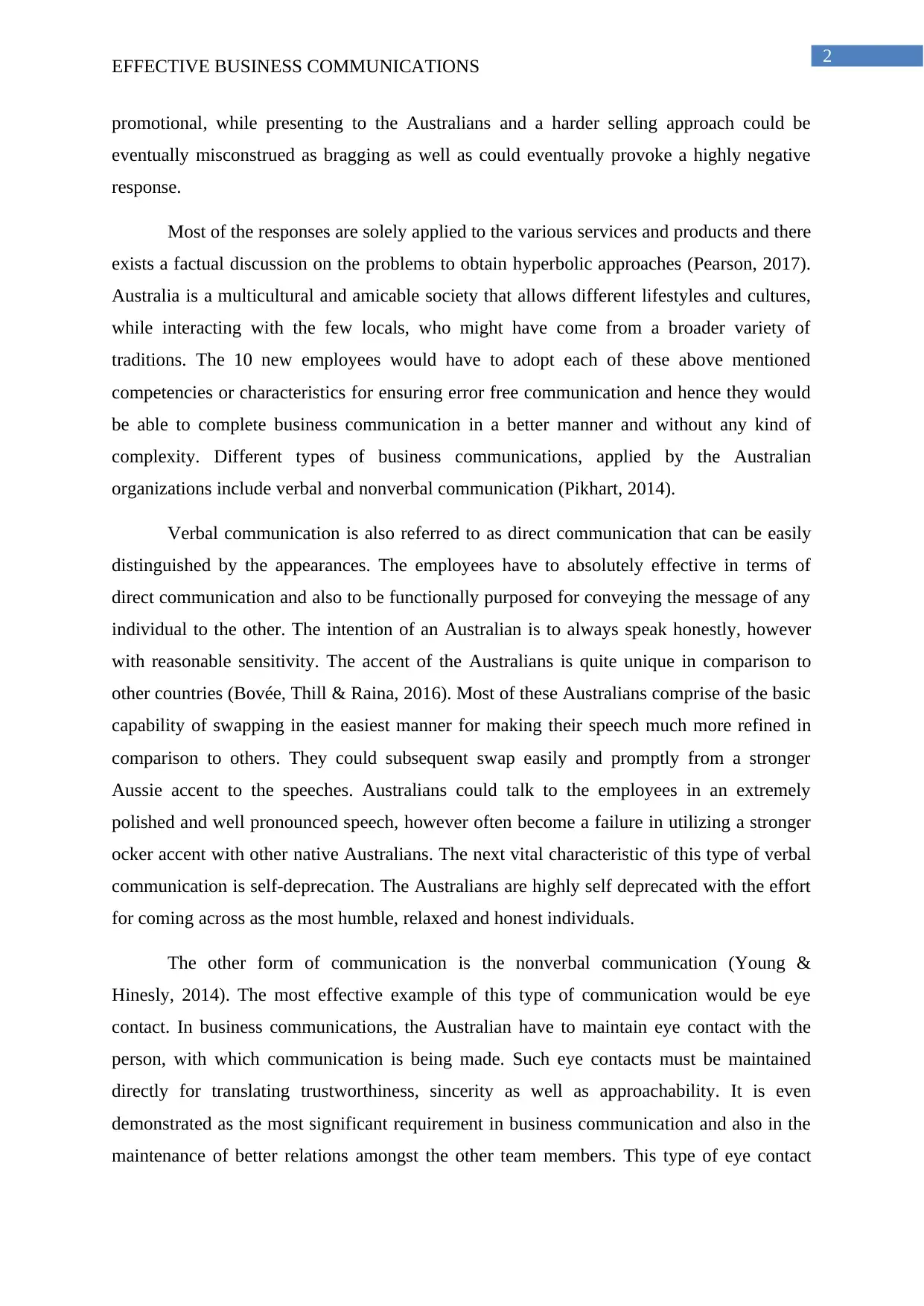
2
EFFECTIVE BUSINESS COMMUNICATIONS
promotional, while presenting to the Australians and a harder selling approach could be
eventually misconstrued as bragging as well as could eventually provoke a highly negative
response.
Most of the responses are solely applied to the various services and products and there
exists a factual discussion on the problems to obtain hyperbolic approaches (Pearson, 2017).
Australia is a multicultural and amicable society that allows different lifestyles and cultures,
while interacting with the few locals, who might have come from a broader variety of
traditions. The 10 new employees would have to adopt each of these above mentioned
competencies or characteristics for ensuring error free communication and hence they would
be able to complete business communication in a better manner and without any kind of
complexity. Different types of business communications, applied by the Australian
organizations include verbal and nonverbal communication (Pikhart, 2014).
Verbal communication is also referred to as direct communication that can be easily
distinguished by the appearances. The employees have to absolutely effective in terms of
direct communication and also to be functionally purposed for conveying the message of any
individual to the other. The intention of an Australian is to always speak honestly, however
with reasonable sensitivity. The accent of the Australians is quite unique in comparison to
other countries (Bovée, Thill & Raina, 2016). Most of these Australians comprise of the basic
capability of swapping in the easiest manner for making their speech much more refined in
comparison to others. They could subsequent swap easily and promptly from a stronger
Aussie accent to the speeches. Australians could talk to the employees in an extremely
polished and well pronounced speech, however often become a failure in utilizing a stronger
ocker accent with other native Australians. The next vital characteristic of this type of verbal
communication is self-deprecation. The Australians are highly self deprecated with the effort
for coming across as the most humble, relaxed and honest individuals.
The other form of communication is the nonverbal communication (Young &
Hinesly, 2014). The most effective example of this type of communication would be eye
contact. In business communications, the Australian have to maintain eye contact with the
person, with which communication is being made. Such eye contacts must be maintained
directly for translating trustworthiness, sincerity as well as approachability. It is even
demonstrated as the most significant requirement in business communication and also in the
maintenance of better relations amongst the other team members. This type of eye contact
EFFECTIVE BUSINESS COMMUNICATIONS
promotional, while presenting to the Australians and a harder selling approach could be
eventually misconstrued as bragging as well as could eventually provoke a highly negative
response.
Most of the responses are solely applied to the various services and products and there
exists a factual discussion on the problems to obtain hyperbolic approaches (Pearson, 2017).
Australia is a multicultural and amicable society that allows different lifestyles and cultures,
while interacting with the few locals, who might have come from a broader variety of
traditions. The 10 new employees would have to adopt each of these above mentioned
competencies or characteristics for ensuring error free communication and hence they would
be able to complete business communication in a better manner and without any kind of
complexity. Different types of business communications, applied by the Australian
organizations include verbal and nonverbal communication (Pikhart, 2014).
Verbal communication is also referred to as direct communication that can be easily
distinguished by the appearances. The employees have to absolutely effective in terms of
direct communication and also to be functionally purposed for conveying the message of any
individual to the other. The intention of an Australian is to always speak honestly, however
with reasonable sensitivity. The accent of the Australians is quite unique in comparison to
other countries (Bovée, Thill & Raina, 2016). Most of these Australians comprise of the basic
capability of swapping in the easiest manner for making their speech much more refined in
comparison to others. They could subsequent swap easily and promptly from a stronger
Aussie accent to the speeches. Australians could talk to the employees in an extremely
polished and well pronounced speech, however often become a failure in utilizing a stronger
ocker accent with other native Australians. The next vital characteristic of this type of verbal
communication is self-deprecation. The Australians are highly self deprecated with the effort
for coming across as the most humble, relaxed and honest individuals.
The other form of communication is the nonverbal communication (Young &
Hinesly, 2014). The most effective example of this type of communication would be eye
contact. In business communications, the Australian have to maintain eye contact with the
person, with which communication is being made. Such eye contacts must be maintained
directly for translating trustworthiness, sincerity as well as approachability. It is even
demonstrated as the most significant requirement in business communication and also in the
maintenance of better relations amongst the other team members. This type of eye contact
⊘ This is a preview!⊘
Do you want full access?
Subscribe today to unlock all pages.

Trusted by 1+ million students worldwide
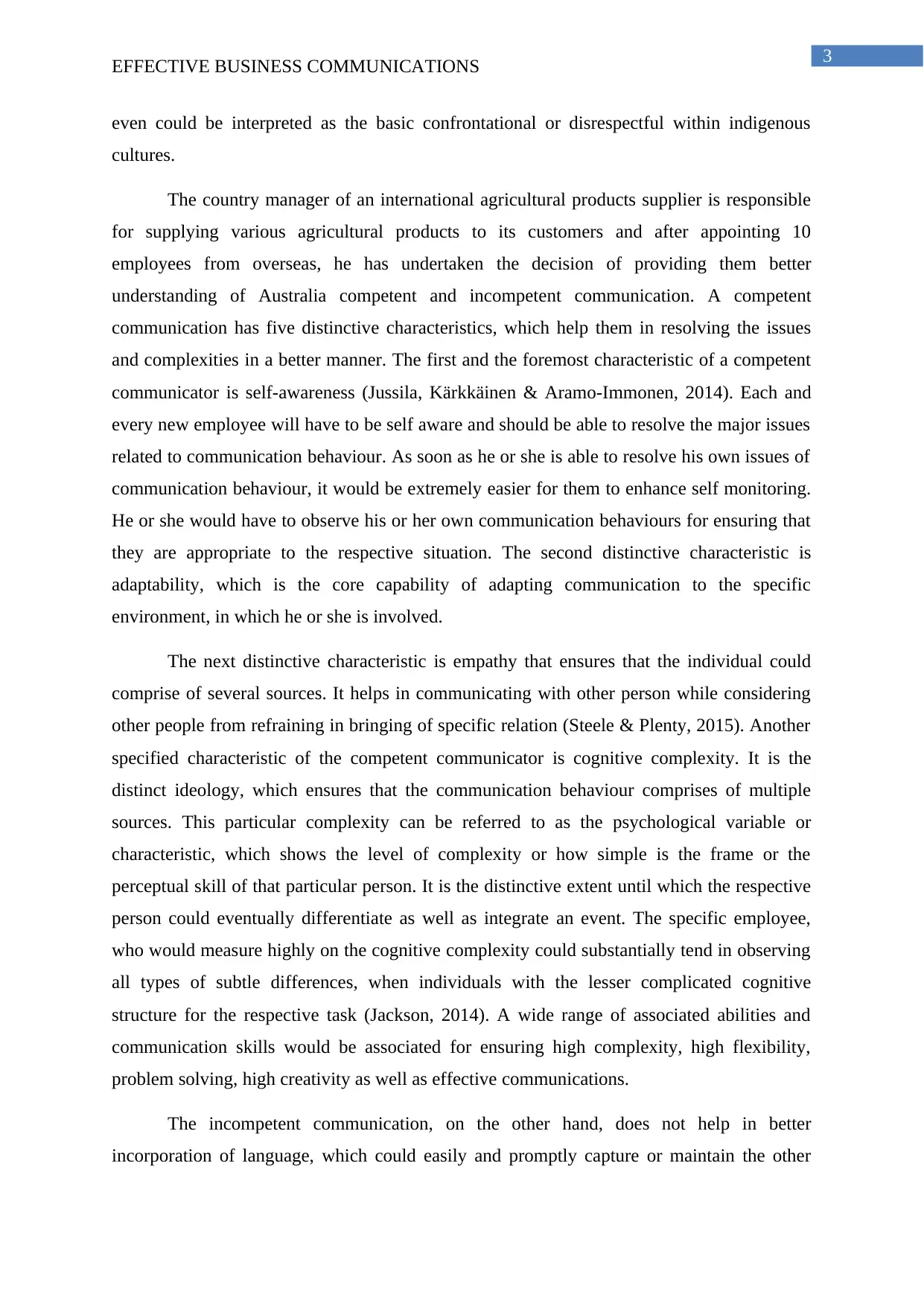
3
EFFECTIVE BUSINESS COMMUNICATIONS
even could be interpreted as the basic confrontational or disrespectful within indigenous
cultures.
The country manager of an international agricultural products supplier is responsible
for supplying various agricultural products to its customers and after appointing 10
employees from overseas, he has undertaken the decision of providing them better
understanding of Australia competent and incompetent communication. A competent
communication has five distinctive characteristics, which help them in resolving the issues
and complexities in a better manner. The first and the foremost characteristic of a competent
communicator is self-awareness (Jussila, Kärkkäinen & Aramo-Immonen, 2014). Each and
every new employee will have to be self aware and should be able to resolve the major issues
related to communication behaviour. As soon as he or she is able to resolve his own issues of
communication behaviour, it would be extremely easier for them to enhance self monitoring.
He or she would have to observe his or her own communication behaviours for ensuring that
they are appropriate to the respective situation. The second distinctive characteristic is
adaptability, which is the core capability of adapting communication to the specific
environment, in which he or she is involved.
The next distinctive characteristic is empathy that ensures that the individual could
comprise of several sources. It helps in communicating with other person while considering
other people from refraining in bringing of specific relation (Steele & Plenty, 2015). Another
specified characteristic of the competent communicator is cognitive complexity. It is the
distinct ideology, which ensures that the communication behaviour comprises of multiple
sources. This particular complexity can be referred to as the psychological variable or
characteristic, which shows the level of complexity or how simple is the frame or the
perceptual skill of that particular person. It is the distinctive extent until which the respective
person could eventually differentiate as well as integrate an event. The specific employee,
who would measure highly on the cognitive complexity could substantially tend in observing
all types of subtle differences, when individuals with the lesser complicated cognitive
structure for the respective task (Jackson, 2014). A wide range of associated abilities and
communication skills would be associated for ensuring high complexity, high flexibility,
problem solving, high creativity as well as effective communications.
The incompetent communication, on the other hand, does not help in better
incorporation of language, which could easily and promptly capture or maintain the other
EFFECTIVE BUSINESS COMMUNICATIONS
even could be interpreted as the basic confrontational or disrespectful within indigenous
cultures.
The country manager of an international agricultural products supplier is responsible
for supplying various agricultural products to its customers and after appointing 10
employees from overseas, he has undertaken the decision of providing them better
understanding of Australia competent and incompetent communication. A competent
communication has five distinctive characteristics, which help them in resolving the issues
and complexities in a better manner. The first and the foremost characteristic of a competent
communicator is self-awareness (Jussila, Kärkkäinen & Aramo-Immonen, 2014). Each and
every new employee will have to be self aware and should be able to resolve the major issues
related to communication behaviour. As soon as he or she is able to resolve his own issues of
communication behaviour, it would be extremely easier for them to enhance self monitoring.
He or she would have to observe his or her own communication behaviours for ensuring that
they are appropriate to the respective situation. The second distinctive characteristic is
adaptability, which is the core capability of adapting communication to the specific
environment, in which he or she is involved.
The next distinctive characteristic is empathy that ensures that the individual could
comprise of several sources. It helps in communicating with other person while considering
other people from refraining in bringing of specific relation (Steele & Plenty, 2015). Another
specified characteristic of the competent communicator is cognitive complexity. It is the
distinct ideology, which ensures that the communication behaviour comprises of multiple
sources. This particular complexity can be referred to as the psychological variable or
characteristic, which shows the level of complexity or how simple is the frame or the
perceptual skill of that particular person. It is the distinctive extent until which the respective
person could eventually differentiate as well as integrate an event. The specific employee,
who would measure highly on the cognitive complexity could substantially tend in observing
all types of subtle differences, when individuals with the lesser complicated cognitive
structure for the respective task (Jackson, 2014). A wide range of associated abilities and
communication skills would be associated for ensuring high complexity, high flexibility,
problem solving, high creativity as well as effective communications.
The incompetent communication, on the other hand, does not help in better
incorporation of language, which could easily and promptly capture or maintain the other
Paraphrase This Document
Need a fresh take? Get an instant paraphrase of this document with our AI Paraphraser
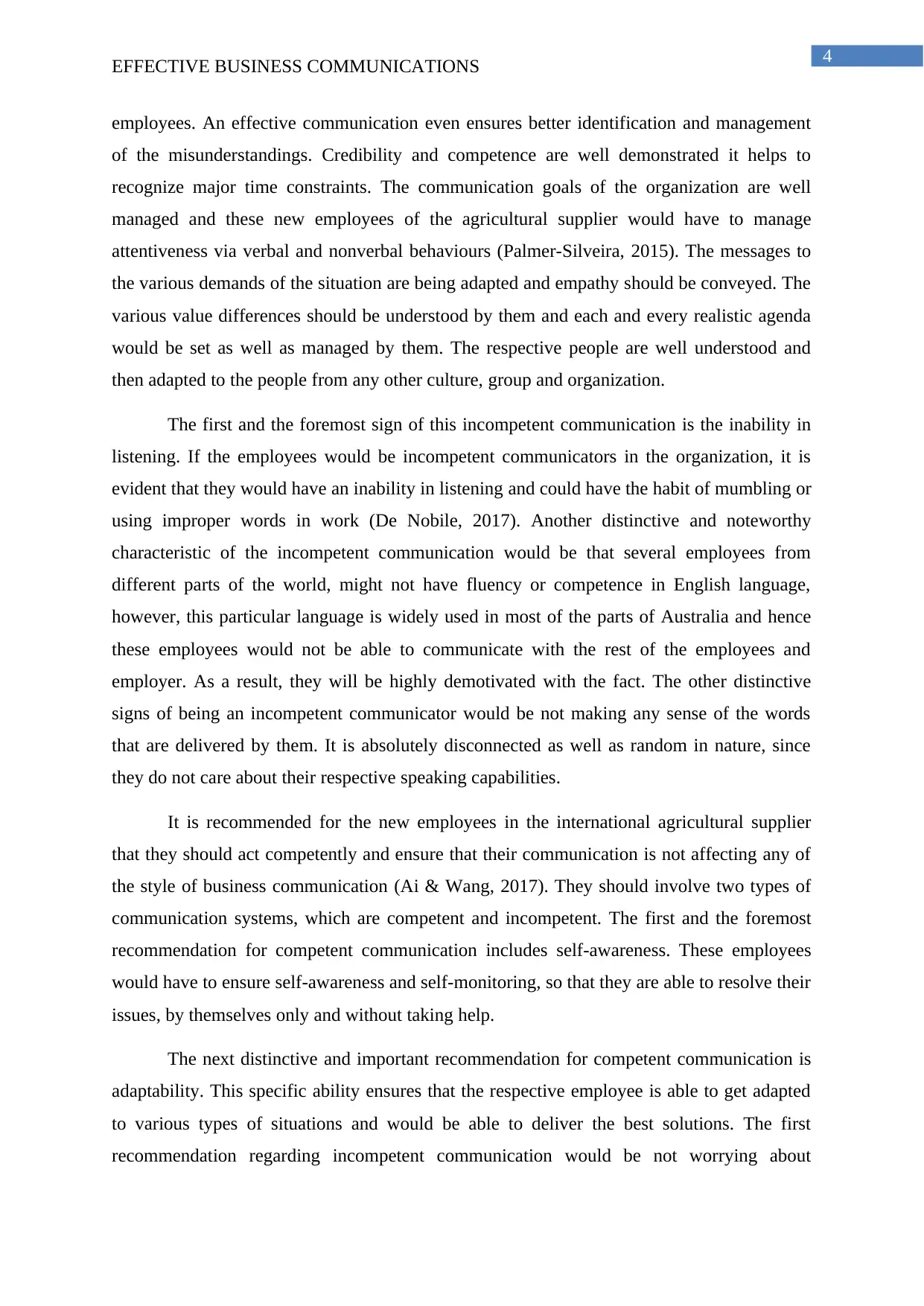
4
EFFECTIVE BUSINESS COMMUNICATIONS
employees. An effective communication even ensures better identification and management
of the misunderstandings. Credibility and competence are well demonstrated it helps to
recognize major time constraints. The communication goals of the organization are well
managed and these new employees of the agricultural supplier would have to manage
attentiveness via verbal and nonverbal behaviours (Palmer-Silveira, 2015). The messages to
the various demands of the situation are being adapted and empathy should be conveyed. The
various value differences should be understood by them and each and every realistic agenda
would be set as well as managed by them. The respective people are well understood and
then adapted to the people from any other culture, group and organization.
The first and the foremost sign of this incompetent communication is the inability in
listening. If the employees would be incompetent communicators in the organization, it is
evident that they would have an inability in listening and could have the habit of mumbling or
using improper words in work (De Nobile, 2017). Another distinctive and noteworthy
characteristic of the incompetent communication would be that several employees from
different parts of the world, might not have fluency or competence in English language,
however, this particular language is widely used in most of the parts of Australia and hence
these employees would not be able to communicate with the rest of the employees and
employer. As a result, they will be highly demotivated with the fact. The other distinctive
signs of being an incompetent communicator would be not making any sense of the words
that are delivered by them. It is absolutely disconnected as well as random in nature, since
they do not care about their respective speaking capabilities.
It is recommended for the new employees in the international agricultural supplier
that they should act competently and ensure that their communication is not affecting any of
the style of business communication (Ai & Wang, 2017). They should involve two types of
communication systems, which are competent and incompetent. The first and the foremost
recommendation for competent communication includes self-awareness. These employees
would have to ensure self-awareness and self-monitoring, so that they are able to resolve their
issues, by themselves only and without taking help.
The next distinctive and important recommendation for competent communication is
adaptability. This specific ability ensures that the respective employee is able to get adapted
to various types of situations and would be able to deliver the best solutions. The first
recommendation regarding incompetent communication would be not worrying about
EFFECTIVE BUSINESS COMMUNICATIONS
employees. An effective communication even ensures better identification and management
of the misunderstandings. Credibility and competence are well demonstrated it helps to
recognize major time constraints. The communication goals of the organization are well
managed and these new employees of the agricultural supplier would have to manage
attentiveness via verbal and nonverbal behaviours (Palmer-Silveira, 2015). The messages to
the various demands of the situation are being adapted and empathy should be conveyed. The
various value differences should be understood by them and each and every realistic agenda
would be set as well as managed by them. The respective people are well understood and
then adapted to the people from any other culture, group and organization.
The first and the foremost sign of this incompetent communication is the inability in
listening. If the employees would be incompetent communicators in the organization, it is
evident that they would have an inability in listening and could have the habit of mumbling or
using improper words in work (De Nobile, 2017). Another distinctive and noteworthy
characteristic of the incompetent communication would be that several employees from
different parts of the world, might not have fluency or competence in English language,
however, this particular language is widely used in most of the parts of Australia and hence
these employees would not be able to communicate with the rest of the employees and
employer. As a result, they will be highly demotivated with the fact. The other distinctive
signs of being an incompetent communicator would be not making any sense of the words
that are delivered by them. It is absolutely disconnected as well as random in nature, since
they do not care about their respective speaking capabilities.
It is recommended for the new employees in the international agricultural supplier
that they should act competently and ensure that their communication is not affecting any of
the style of business communication (Ai & Wang, 2017). They should involve two types of
communication systems, which are competent and incompetent. The first and the foremost
recommendation for competent communication includes self-awareness. These employees
would have to ensure self-awareness and self-monitoring, so that they are able to resolve their
issues, by themselves only and without taking help.
The next distinctive and important recommendation for competent communication is
adaptability. This specific ability ensures that the respective employee is able to get adapted
to various types of situations and would be able to deliver the best solutions. The first
recommendation regarding incompetent communication would be not worrying about
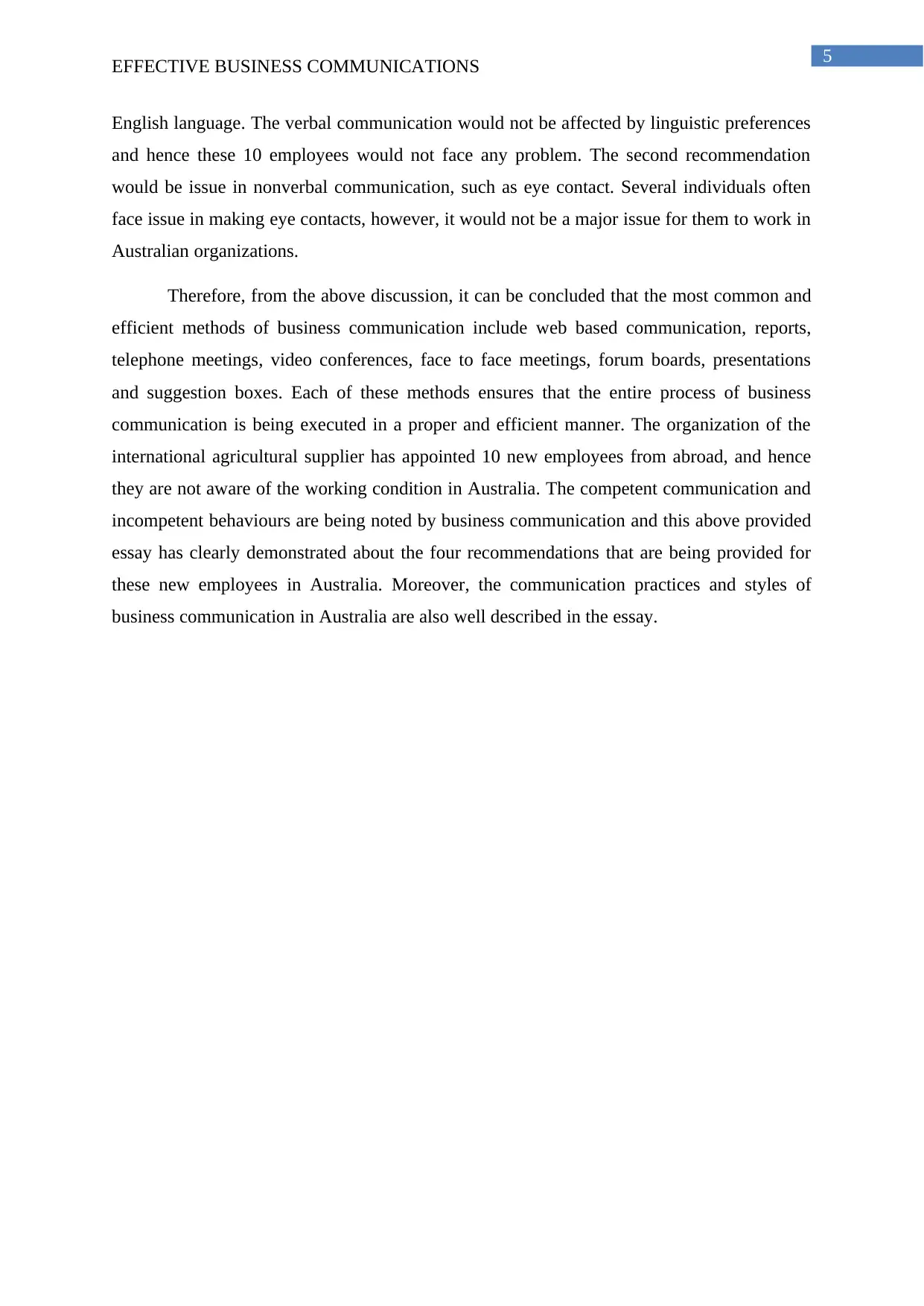
5
EFFECTIVE BUSINESS COMMUNICATIONS
English language. The verbal communication would not be affected by linguistic preferences
and hence these 10 employees would not face any problem. The second recommendation
would be issue in nonverbal communication, such as eye contact. Several individuals often
face issue in making eye contacts, however, it would not be a major issue for them to work in
Australian organizations.
Therefore, from the above discussion, it can be concluded that the most common and
efficient methods of business communication include web based communication, reports,
telephone meetings, video conferences, face to face meetings, forum boards, presentations
and suggestion boxes. Each of these methods ensures that the entire process of business
communication is being executed in a proper and efficient manner. The organization of the
international agricultural supplier has appointed 10 new employees from abroad, and hence
they are not aware of the working condition in Australia. The competent communication and
incompetent behaviours are being noted by business communication and this above provided
essay has clearly demonstrated about the four recommendations that are being provided for
these new employees in Australia. Moreover, the communication practices and styles of
business communication in Australia are also well described in the essay.
EFFECTIVE BUSINESS COMMUNICATIONS
English language. The verbal communication would not be affected by linguistic preferences
and hence these 10 employees would not face any problem. The second recommendation
would be issue in nonverbal communication, such as eye contact. Several individuals often
face issue in making eye contacts, however, it would not be a major issue for them to work in
Australian organizations.
Therefore, from the above discussion, it can be concluded that the most common and
efficient methods of business communication include web based communication, reports,
telephone meetings, video conferences, face to face meetings, forum boards, presentations
and suggestion boxes. Each of these methods ensures that the entire process of business
communication is being executed in a proper and efficient manner. The organization of the
international agricultural supplier has appointed 10 new employees from abroad, and hence
they are not aware of the working condition in Australia. The competent communication and
incompetent behaviours are being noted by business communication and this above provided
essay has clearly demonstrated about the four recommendations that are being provided for
these new employees in Australia. Moreover, the communication practices and styles of
business communication in Australia are also well described in the essay.
⊘ This is a preview!⊘
Do you want full access?
Subscribe today to unlock all pages.

Trusted by 1+ million students worldwide
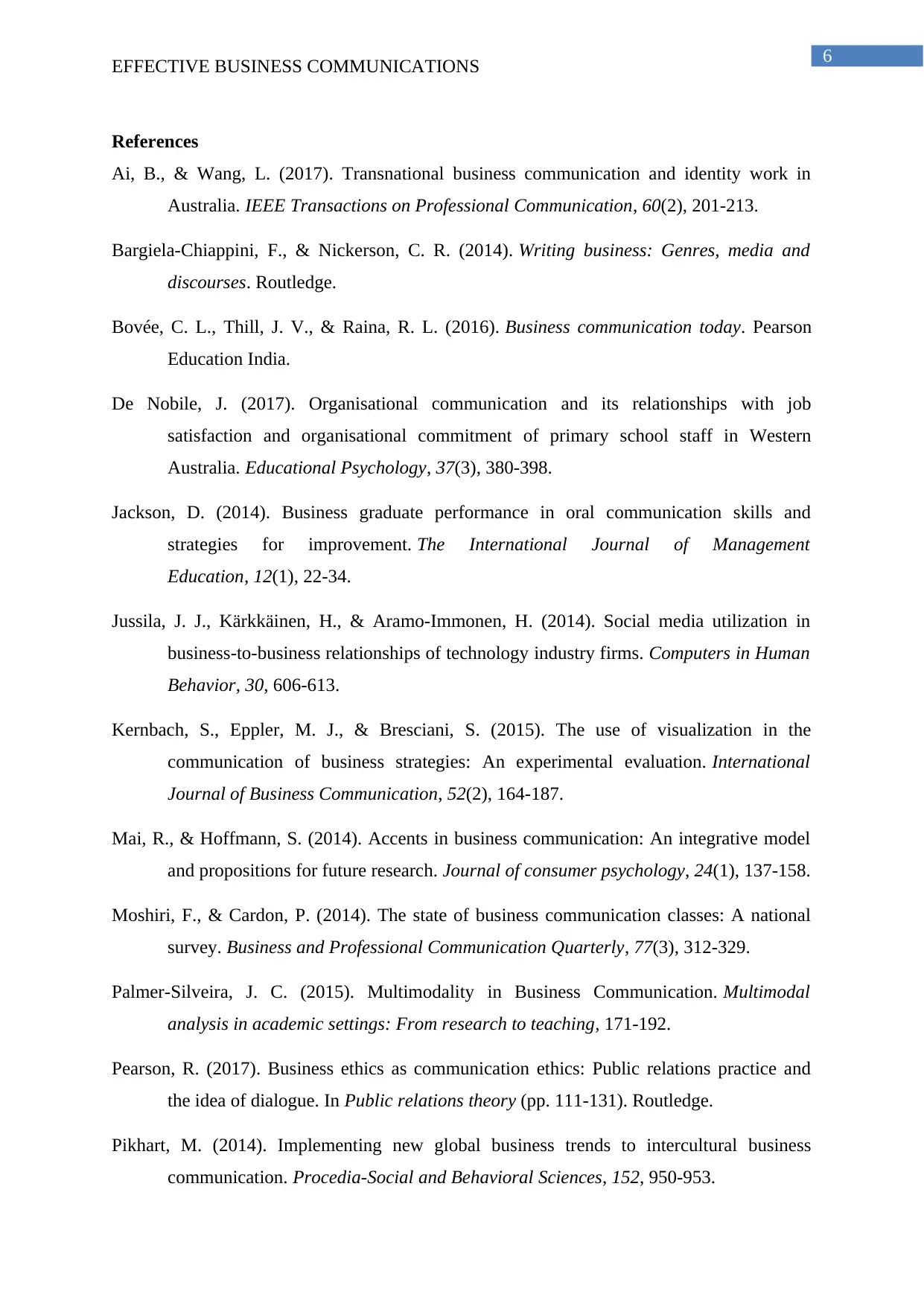
6
EFFECTIVE BUSINESS COMMUNICATIONS
References
Ai, B., & Wang, L. (2017). Transnational business communication and identity work in
Australia. IEEE Transactions on Professional Communication, 60(2), 201-213.
Bargiela-Chiappini, F., & Nickerson, C. R. (2014). Writing business: Genres, media and
discourses. Routledge.
Bovée, C. L., Thill, J. V., & Raina, R. L. (2016). Business communication today. Pearson
Education India.
De Nobile, J. (2017). Organisational communication and its relationships with job
satisfaction and organisational commitment of primary school staff in Western
Australia. Educational Psychology, 37(3), 380-398.
Jackson, D. (2014). Business graduate performance in oral communication skills and
strategies for improvement. The International Journal of Management
Education, 12(1), 22-34.
Jussila, J. J., Kärkkäinen, H., & Aramo-Immonen, H. (2014). Social media utilization in
business-to-business relationships of technology industry firms. Computers in Human
Behavior, 30, 606-613.
Kernbach, S., Eppler, M. J., & Bresciani, S. (2015). The use of visualization in the
communication of business strategies: An experimental evaluation. International
Journal of Business Communication, 52(2), 164-187.
Mai, R., & Hoffmann, S. (2014). Accents in business communication: An integrative model
and propositions for future research. Journal of consumer psychology, 24(1), 137-158.
Moshiri, F., & Cardon, P. (2014). The state of business communication classes: A national
survey. Business and Professional Communication Quarterly, 77(3), 312-329.
Palmer-Silveira, J. C. (2015). Multimodality in Business Communication. Multimodal
analysis in academic settings: From research to teaching, 171-192.
Pearson, R. (2017). Business ethics as communication ethics: Public relations practice and
the idea of dialogue. In Public relations theory (pp. 111-131). Routledge.
Pikhart, M. (2014). Implementing new global business trends to intercultural business
communication. Procedia-Social and Behavioral Sciences, 152, 950-953.
EFFECTIVE BUSINESS COMMUNICATIONS
References
Ai, B., & Wang, L. (2017). Transnational business communication and identity work in
Australia. IEEE Transactions on Professional Communication, 60(2), 201-213.
Bargiela-Chiappini, F., & Nickerson, C. R. (2014). Writing business: Genres, media and
discourses. Routledge.
Bovée, C. L., Thill, J. V., & Raina, R. L. (2016). Business communication today. Pearson
Education India.
De Nobile, J. (2017). Organisational communication and its relationships with job
satisfaction and organisational commitment of primary school staff in Western
Australia. Educational Psychology, 37(3), 380-398.
Jackson, D. (2014). Business graduate performance in oral communication skills and
strategies for improvement. The International Journal of Management
Education, 12(1), 22-34.
Jussila, J. J., Kärkkäinen, H., & Aramo-Immonen, H. (2014). Social media utilization in
business-to-business relationships of technology industry firms. Computers in Human
Behavior, 30, 606-613.
Kernbach, S., Eppler, M. J., & Bresciani, S. (2015). The use of visualization in the
communication of business strategies: An experimental evaluation. International
Journal of Business Communication, 52(2), 164-187.
Mai, R., & Hoffmann, S. (2014). Accents in business communication: An integrative model
and propositions for future research. Journal of consumer psychology, 24(1), 137-158.
Moshiri, F., & Cardon, P. (2014). The state of business communication classes: A national
survey. Business and Professional Communication Quarterly, 77(3), 312-329.
Palmer-Silveira, J. C. (2015). Multimodality in Business Communication. Multimodal
analysis in academic settings: From research to teaching, 171-192.
Pearson, R. (2017). Business ethics as communication ethics: Public relations practice and
the idea of dialogue. In Public relations theory (pp. 111-131). Routledge.
Pikhart, M. (2014). Implementing new global business trends to intercultural business
communication. Procedia-Social and Behavioral Sciences, 152, 950-953.
Paraphrase This Document
Need a fresh take? Get an instant paraphrase of this document with our AI Paraphraser
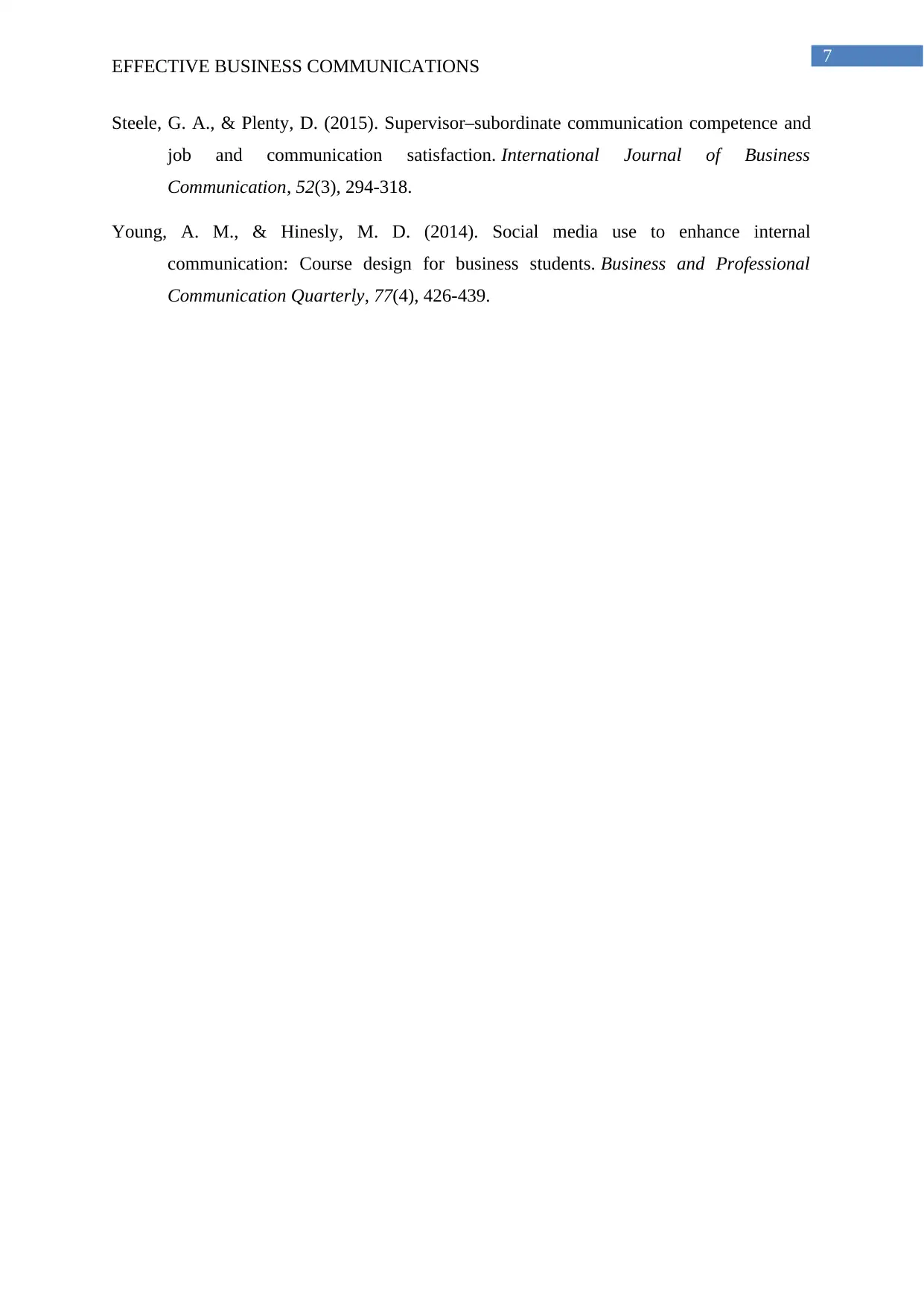
7
EFFECTIVE BUSINESS COMMUNICATIONS
Steele, G. A., & Plenty, D. (2015). Supervisor–subordinate communication competence and
job and communication satisfaction. International Journal of Business
Communication, 52(3), 294-318.
Young, A. M., & Hinesly, M. D. (2014). Social media use to enhance internal
communication: Course design for business students. Business and Professional
Communication Quarterly, 77(4), 426-439.
EFFECTIVE BUSINESS COMMUNICATIONS
Steele, G. A., & Plenty, D. (2015). Supervisor–subordinate communication competence and
job and communication satisfaction. International Journal of Business
Communication, 52(3), 294-318.
Young, A. M., & Hinesly, M. D. (2014). Social media use to enhance internal
communication: Course design for business students. Business and Professional
Communication Quarterly, 77(4), 426-439.
1 out of 8
Related Documents
Your All-in-One AI-Powered Toolkit for Academic Success.
+13062052269
info@desklib.com
Available 24*7 on WhatsApp / Email
![[object Object]](/_next/static/media/star-bottom.7253800d.svg)
Unlock your academic potential
Copyright © 2020–2025 A2Z Services. All Rights Reserved. Developed and managed by ZUCOL.





